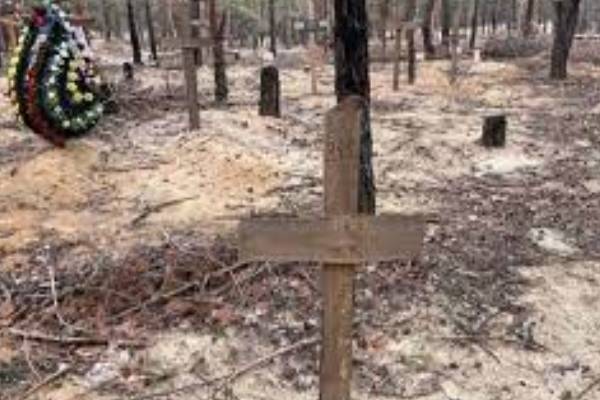Ukrainian authorities have found 440 graves at a mass burial site in Izium, an eastern city recently recaptured from Russian forces, Ukraine’s Defense Ministry said in a Twitter post Friday.
Earlier Ukrainian President Volodymyr Zelensky said Ukrainian and international journalists would be shown the site to see what had been uncovered. “We want the world to know what is really happening and what the Russian occupation has led to,” Zelensky said.
Ukraine’s Center for Strategic Communications said on Thursday that some of the graves discovered at Izium were “fresh,” and that the corpses buried there were “mostly civilians.”
Izium was subject to intense Russian artillery attacks in April, and the city, which sits near the border between the Kharkiv and Donetsk regions, became an important hub for the invading military during five months of occupation.
Ukrainian forces took back control of the city on Saturday, delivering a strategic blow to Russia’s military assault in the east.
Photos released by the Ukrainian Defense Ministry on Friday showed numerous crosses on mounds in a wooded area near Izium, as well as a larger pit dug into the forest floor.
Zelensky said during his address on Thursday that Russia must be held accountable for deaths there, and in other cities where large numbers of bodies had been found.
“Bucha, Mariupol and now, unfortunately, Izium… Russia leaves death everywhere. And must be responsible for it. The world must hold Russia to real responsibility for this war. We will do everything for this,” he added.
Serhii Bolvinov, the chief police investigator for the Kharkiv region, earlier told Britain’s Sky News that there may be other mass burial sites in the Kharkiv area.
Talking specifically about the 440 graves, Bolvinov told Sky News exhumations so far showed the victims died from various causes.
“We know that some were killed (shot dead), some died because of artillery fire, so-called mine explosion traumas. Some died because of airstrikes. Also we have information that a lot of bodies have not been identified yet. So the reasons of death will be established during the investigations,” Sky News quoted Bolvinov as saying.
Meanwhile, Oleh Kotenko, Ukraine’s commissioner for missing persons, said in a Telegram post that search operations for the remains of “fallen heroes” were proceeding cautiously throughout the region.
“The biggest problem is that some areas are still mined. Despite this, we continue to work, because we have to return each hero home so that the families can honor the memory of the soldiers who died for Ukraine in a dignified manner as soon as possible,” Kotenko said.
Zelensky visited Izium on Wednesday and told journalists he was “shocked” by the number of “destroyed buildings” and “killed people” left in the wake of the Russian occupation.
A United Nations source has told CNN that a team from the UN’s human rights monitoring agency — the OCHR — would be going to Izium and areas around it as soon as possible.
The War Crimes investigation team may follow after that, the source said. Their specific destination remains unclear at this time.
Moscow was using Izium as a launching pad for attacks southward into the Donetsk region and Kupyansk, some 48 kilometers (30 miles) to the north of Izium, and as a rail hub to resupply its forces.
Zelensky also thanked foreign governments for sending investigators and prosecutors to investigate alleged human rights abuses by occupying forces in Ukraine, adding that all occupied areas would eventually return.
Ukrainian forces have been on a sustained military offensive, particularly in the country’s northeast and southern regions.
Zelensky said on Tuesday that 8,000 square kilometers (3,088 square miles) of territory had now been liberated by Ukrainian forces so far this month, with roughly half the area still undergoing “stabilization” measures.
The discovery is another example of what the Ukrainian authorities refer to as War Crimes and Genocide following the discovery of alleged Mass graves in many formerly Russian occupied parts of the Country before.





